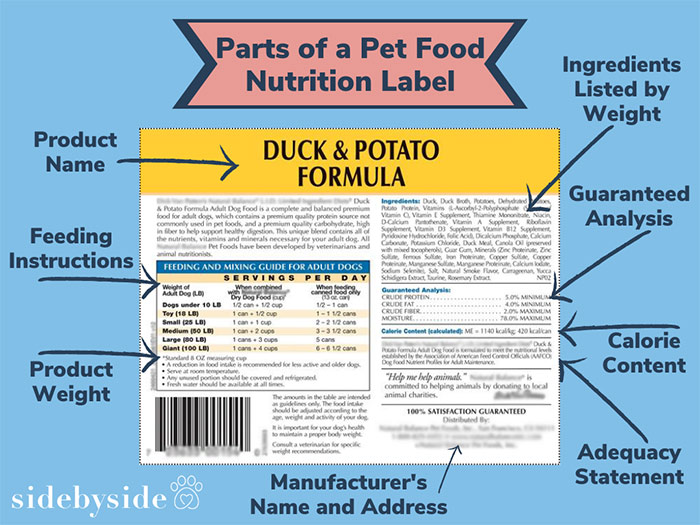To read dog food labels, start by checking the ingredients list and guaranteed analysis. Focus on high-quality protein sources and avoid fillers or artificial additives.
Understanding dog food labels is crucial for ensuring your pet’s health and well-being. Labels provide essential information about the nutritional content and ingredient quality. Pet owners should prioritize high-quality proteins, whole grains, and healthy fats. Familiarizing yourself with the terms used can help you make informed choices.
Look for the Association of American Feed Control Officials (AAFCO) statement, which confirms the food meets nutritional standards. Analyzing the label carefully allows you to select a diet tailored to your dog’s specific needs. This knowledge not only keeps your furry friend healthy but also enhances their energy levels and overall happiness.

Credit: foreverfreckled.com
Deciphering The Language Of Dog Food Labels
Understanding dog food labels is essential for pet owners. Labels contain crucial information about nutrition and ingredients. Learning to read these labels helps you make informed choices. This section will simplify the terms and regulations surrounding dog food labeling.
Key Terms In Pet Food Labeling
Familiarizing yourself with common terms helps in understanding dog food labels. Here are some key terms:
- Guaranteed Analysis: Displays minimum and maximum nutrient levels.
- Ingredients List: Shows all components in the food.
- By-Products: Parts of animals not classified as meat.
- Complete and Balanced: Meets the nutritional needs of dogs.
- AAFCO: Association of American Feed Control Officials. Sets standards for pet food.
Regulatory Bodies And Label Requirements
Various regulatory bodies oversee pet food labeling. They ensure safety and nutritional value. Here are some important bodies and their roles:
| Regulatory Body | Role |
|---|---|
| FDA | Monitors pet food safety and labeling. |
| AAPCO | Establishes nutrient profiles for pet food. |
| State Departments | Enforce regulations at the state level. |
Pet food labels must include specific information. This includes the product name, net weight, and feeding instructions. Knowing these requirements helps you choose safe and nutritious food for your pet.
Ingredients List Breakdown
Understanding dog food labels starts with the ingredients list. This list reveals what goes into your dog's food. Knowing how to read it helps you choose the best nutrition for your pet.
Order Of Ingredients And What It Means
The ingredients list follows a specific order. Ingredients are listed by weight, from highest to lowest. This means the first few items are the most significant. For example:
- Meat: It should be the first ingredient.
- Grains: Look for whole grains, like brown rice.
- Vegetables: They provide essential vitamins.
Be cautious of vague terms like “meat meal” or “by-products.” These can indicate lower quality. Always choose brands with clear, specific ingredients.
Common Ingredients And Their Nutritional Value
| Ingredient | Nutritional Value |
|---|---|
| Chicken | High in protein and essential amino acids. |
| Brown Rice | Provides energy and fiber for digestion. |
| Sweet Potatoes | Rich in vitamins and a great source of fiber. |
| Fish Oil | Source of omega-3 fatty acids for a healthy coat. |
| Carrots | High in beta-carotene and good for vision. |
Check for these ingredients to ensure balanced nutrition. Avoid foods with fillers like corn or soy. These offer little nutritional value.
Nutritional Adequacy Statement
The Nutritional Adequacy Statement is essential for choosing dog food. It indicates if the food meets your dog’s dietary needs. This statement is often found on the back or side of the bag. Understanding this statement helps ensure your pet stays healthy.
Understanding Aafco Statements
The Association of American Feed Control Officials (AAFCO) sets the standards for pet food. Look for AAFCO statements to determine food quality. These statements come in two main forms:
- Formulation Statement: This means the food is made using tested recipes.
- Feeding Trial Statement: This shows the food was tested on real dogs.
Check for phrases like “complete and balanced” in the statement. This means the food provides all essential nutrients. If the label lacks an AAFCO statement, consider another brand.
Life Stage Feeding Recommendations
Dog food should match your pet's life stage. AAFCO provides guidelines for:
| Life Stage | Description |
|---|---|
| Puppy | Food supports growth and development. |
| Adult | Food maintains health and weight. |
| Senior | Food aids in joint health and digestion. |
Choose food based on your dog’s age. Puppies need more calories. Adult dogs need balanced nutrition. Senior dogs require food that supports their aging bodies.
Guaranteed Analysis Explained
Understanding the Guaranteed Analysis on dog food labels is crucial. This section provides key information on the nutrient content. It helps you choose the best food for your dog’s needs. Focus on the percentages of protein, fat, fiber, and moisture.
Interpreting Protein
Protein is essential for your dog's growth and health. It helps build muscles and supports overall body function. Look for the protein percentage in the Guaranteed Analysis.
- Higher protein content is better for active dogs.
- Moderate protein is suitable for less active dogs.
Common protein sources include:
- Chicken
- Beef
- Fish
Check if the protein source is named. For example, “chicken” is better than “meat”.
Fat
Fat provides energy and supports skin and coat health. Look for healthy fat sources like fish oil or chicken fat. The fat percentage is also listed in the Guaranteed Analysis.
- Higher fat content supports active dogs.
- Lower fat is better for dogs needing to lose weight.
Healthy fats improve nutrient absorption. They also keep your dog’s coat shiny.
Fiber
Fiber aids digestion and keeps your dog feeling full. The fiber percentage is important for weight management. Look for natural fiber sources like:
- Beet pulp
- Brown rice
- Peas
Too much fiber can cause digestive issues. Balance is key.
Moisture Content
Moisture content shows how much water is in the food. Dry dog food usually has about 10% moisture. Wet food can have up to 78% moisture. Consider your dog’s hydration needs.
Comparing Nutrient Profiles Of Different Foods
Comparing nutrient profiles helps in making informed choices. Use the Guaranteed Analysis to evaluate different brands. Create a simple table for easy comparison:
| Brand | Protein (%) | Fat (%) | Fiber (%) | Moisture (%) |
|---|---|---|---|---|
| Brand A | 25 | 15 | 5 | 10 |
| Brand B | 30 | 10 | 4 | 12 |
| Brand C | 20 | 18 | 6 | 10 |
Choose the food that best meets your dog's nutritional needs. Higher protein is ideal for active dogs. Adjust based on your dog's lifestyle and age.
The Fine Print: Additives And Preservatives
Reading dog food labels requires attention to detail. Additives and preservatives play a crucial role in pet food. Understanding these ingredients helps ensure your dog's health. Choose wisely to avoid unwanted chemicals and allergens.
Identifying Artificial Vs. Natural Additives
Additives enhance the flavor, texture, and shelf life of dog food. They can be classified as artificial or natural. Here’s how to distinguish between them:
| Type | Examples | Benefits |
|---|---|---|
| Artificial Additives | Colors, flavors, and preservatives | Enhance appearance and taste |
| Natural Additives | Vitamin E, rosemary extract | Preserve freshness and nutrients |
Artificial additives may pose health risks. Look for natural alternatives. They provide better nutrition and are safer for your dog.
Potential Allergens To Look Out For
Some ingredients can trigger allergies in dogs. Be cautious with the following:
- Wheat – Common allergen in many dog foods.
- Soy – Can cause digestive issues.
- Dairy – Some dogs are lactose intolerant.
- Chicken – A frequent source of allergies.
- Beef – Another common allergen.
Check for these allergens in the ingredient list. Choose grain-free or hypoallergenic formulas if necessary. Your dog’s well-being depends on the right nutrition.

Credit: www.purinainstitute.com
Feeding Guidelines And Portion Sizes
Understanding feeding guidelines and portion sizes helps keep your dog healthy. Proper nutrition starts with the right amounts of food. Each dog has unique needs based on its size, age, and activity level. Reading the label carefully is essential.
Calculating Daily Feeding Amounts
Most dog food labels provide a feeding chart. This chart shows how much food to give your dog based on its weight. Follow these steps to calculate daily feeding amounts:
- Find your dog's weight on the feeding chart.
- Locate the recommended amount of food per day.
- Divide this amount into two or three meals.
For example:
| Dog Weight | Daily Amount (cups) |
|---|---|
| 10 lbs | 1/2 – 1 cup |
| 20 lbs | 1 – 1.5 cups |
| 50 lbs | 2 – 3 cups |
| 100 lbs | 3 – 4 cups |
Adjusting For Weight And Activity Level
Your dog’s weight and activity level impact its food needs. Active dogs require more calories. Less active dogs need fewer calories. Adjust the amount accordingly.
- Active Dogs: Increase food by 10-20%.
- Less Active Dogs: Decrease food by 10-20%.
- Weight Management: Consult your vet for specific guidelines.
Monitor your dog's weight regularly. Adjust the food amount as needed. Keep your dog healthy and happy with the right portion sizes.
Marketing Buzzwords Vs. Nutritional Facts
Dog food labels can be confusing. Many brands use catchy phrases to attract buyers. These marketing buzzwords often mislead pet owners. Understanding the difference between these buzzwords and real nutritional facts is essential. This knowledge helps you choose the best food for your dog.
Decoding Phrases Like ‘grain-free' And ‘human-grade'
The terms ‘grain-free' and ‘human-grade' sound appealing. They suggest high quality. However, they can be misleading. Here’s a quick breakdown:
| Term | Meaning | Considerations |
|---|---|---|
| Grain-Free | No grains like corn or wheat. | May contain high carbs from other sources. |
| Human-Grade | Ingredients fit for human consumption. | Doesn't guarantee better nutrition. |
Always read the ingredients list. A grain-free label does not mean better nutrition. Human-grade does not ensure complete dog nutrition. Check the actual ingredients before making a decision.
The Truth Behind ‘complete And Balanced' Claims
Many dog foods claim to be ‘complete and balanced.' This means they meet AAFCO standards. AAFCO stands for the Association of American Feed Control Officials. These standards ensure basic nutrition for dogs.
- Complete: Contains all essential nutrients.
- Balanced: Nutrient ratios are correct for your dog’s life stage.
However, not all ‘complete and balanced' foods are equal. Quality can vary widely. Look for:
- Named meat as the first ingredient.
- Whole food ingredients.
- Limited fillers and artificial additives.
Always remember, your dog’s health depends on quality nutrition. Choose wisely by focusing on facts, not just marketing hype.

Credit: www.purinainstitute.com
The Impact Of Food Processing On Nutrients
Understanding how food processing affects nutrients is crucial for dog owners. The way dog food is made can change its nutritional value. Some processing methods may reduce essential vitamins and minerals. Others might enhance digestibility. Knowing these differences helps you choose the best food for your pet.
Raw Vs. Cooked: Nutrient Retention In Dog Food
Raw and cooked dog foods have different effects on nutrient retention. Here’s a comparison:
| Aspect | Raw Dog Food | Cooked Dog Food |
|---|---|---|
| Nutrient Retention | Higher for vitamins and enzymes | May lose some vitamins |
| Digestibility | Varies by ingredients | Generally easier to digest |
| Risk of Bacteria | Higher risk of pathogens | Lower risk after cooking |
Raw diets often keep more nutrients intact. Cooking can kill harmful bacteria but may also destroy some vitamins.
Preservation Methods And Their Nutritional Implications
Different preservation methods affect nutrient levels. Here are common methods:
- Freezing: Keeps nutrients well. Maintains flavor and texture.
- Dehydration: Reduces moisture. Preserves most nutrients.
- Canning: High heat can destroy some vitamins. Convenient but may lose texture.
- Drying: Removes moisture. Nutrient levels may vary.
Choose preservation methods wisely. Look for options that maintain nutrient quality. A well-preserved food supports your dog's health.
Frequently Asked Questions
What Should I Look For In Dog Food Labels?
When reading dog food labels, check the ingredient list first. Look for high-quality protein sources like chicken or beef as the first ingredient. Ensure there are no fillers or artificial additives. Additionally, verify the nutritional adequacy statement to confirm it meets your dog's needs.
How Can I Understand Dog Food Ingredients?
Dog food ingredients are listed by weight. The first few items are the most significant. Look for whole foods, like meat or vegetables, rather than by-products. Familiarize yourself with common ingredients and their nutritional benefits to make informed choices for your pet's health.
What Do Terms Like “natural” And “organic” Mean?
“Natural” dog food contains no artificial additives. It emphasizes whole ingredients and minimal processing. “Organic” means the ingredients are grown without synthetic fertilizers or pesticides. Both terms suggest higher quality, but verify certifications and read the label to ensure authenticity.
How Can I Tell If Dog Food Is Nutritious?
To assess dog food's nutritional value, review the guaranteed analysis. This section provides information on protein, fat, fiber, and moisture content. Compare these percentages to your dog's dietary requirements. Additionally, consider the quality of ingredients, focusing on whole foods for optimal nutrition.
Conclusion
Understanding dog food labels is essential for your pet's health. By knowing how to read the ingredients and nutritional information, you can make informed choices. This ensures your furry friend gets the best possible nutrition. Take the time to review labels carefully and prioritize quality for a happy, healthy dog.














